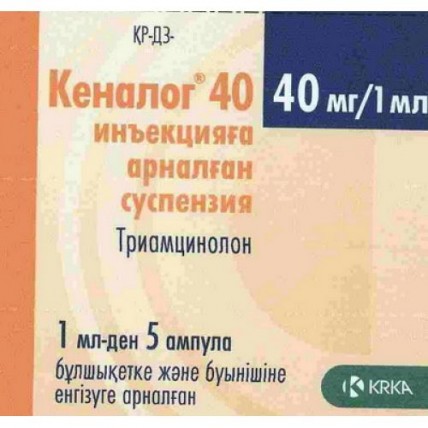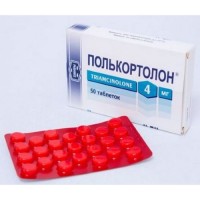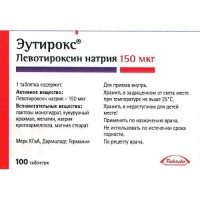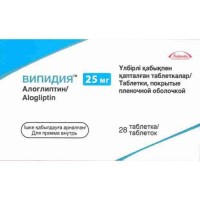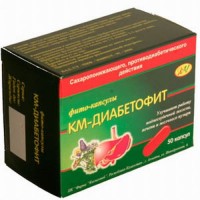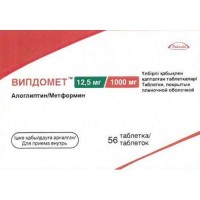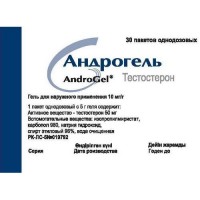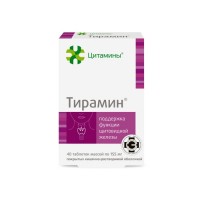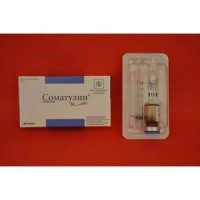Kenalog® 40 40 mg / ml 1 ml 5's suspension for injection in ampoules
- $24.70
The instruction
for medical use
of КЕНАЛОГ® 40 medicine
the Trade name
Кеналог® 40
International unlicensed
name Triamcinolonum Dosage Form Suspension for injections of 40 mg/ml, 1 ml
Structure
of 1 ml of suspension contains
active agent – Triamcinolonum acetonide of 40.0 mg,
excipients: sodium of a karmelloz, sodium chloride, benzyl alcohol, polysorbate 80, water for injections
the Description
White suspension with a light smell of benzyl alcohol, practically without visible inclusions and lumps
Pharmacotherapeutic group
Corticosteroids for system use. Glucocorticosteroids.
Triamcinolonum.
ATH H02AB08 code
the Pharmacological
Pharmacokinetics Later properties of intramuscular introduction of 120 mg of Triamcinolonum of acetonide maximum plasma concentration in blood plasma is reached between 44 and 54 mkg / 100 in ml within from 8 to 10 hours, and decreases to 8.9 mkg / 100 ml after 72 hours after reception.
In three days after an intra articulate injection the absorption of Triamcinolonum of acetonide is from 58% to 67%. Comparison of sizes of the areas under a curve concentration time (AUC) between intra articulate and intramuscular injections shows that absorption in both cases full. Triamcinolonum is metabolized in a liver. Less than 15% of drug are removed in not changed view with urine. Both at local, and at system introduction, corticosteroids are metabolized mainly in a liver. Three metabolites of Triamcinolonum of acetonide are revealed and the metabolic picture is identical to all three ways of their use. Metabolites of Triamcinolonum of acetonide include 6 - beta hydroxytriamcinolonum acetonide, 21 - carboxy - 6 - beta hydroxy-Triamcinolonum acetonide, and 21 carboxytriamcinolonums acetonide.
After introduction of 40 mg of an intramuscular dose of Triamcinolonum of acetonide, in urine 12.5% of the entered dose are found. After single intramuscular introduction of 80 mg of a dose, Triamcinolonum acetonide is found in urine up to 7-11 days. The pharmacokinetics of drug depends on a dose. At use of drug in a dose of 5 mg/kg of body weight the average half-life period was 85 min., at use in a dose of 10 mg/kg - 88 min. The general clearance is 61.6 l/hour for a dosage of 5 mg/kg and 48.2 l/hour - for a dosage of 10 mg/kg.
The pharmacodynamics
of Kenalog®40 renders the anti-inflammatory, antiallergic, desensibilizing, antishock, anti-toxic and immunodepressive effect.
The main effect of Triamcinolonum is connected with glucocorticoid action and oppression of inflammatory reaction. The activity of glucocorticoids leads to strengthening of a gluconeogenesis and reduction of utilization of glucose in fabrics. Catabolism of a protein accelerates, and synthesis from food protein decreases though the general influence on nitrogenous balance depends on other factors, including a diet, a dose and duration of treatment. At use of drug in a dose of 12-24 mg/days there can be a negative nitrogenous balance. Triamcinolonum has insignificant mineralokortikoidny activity.
During treatment by corticosteroids the quantity of erythrocytes and neutrocytes increases, the quantity of eosinophilic granulocytes and basophiles decreases. Also the mass of adenoid tissue decreases. Corticosteroids prevent or initial signs of inflammatory process, such as reddening, morbidity, local fervescence suppress, swelled and also later complications, including proliferation of fibroblasts and adjournment of collagen.
Indications
- allergic reactions: including seasonal year-round allergic rhinitis, bronchial asthma, atopic and contact dermatitis, allergic reaction to medicines, a serum disease and an acute non-infectious laryngeal edema, prevention of a late stage of anaphylactic reactions
- rheumatic diseases: a heavy pseudorheumatism (in a combination with antirheumatic drugs of the slowed-down action), acute gout, an acute nonspecific ankylosing spondylitis, a bursitis, an epicondylitis, a posttraumatic osteoarthrosis, psoriasis arthritis and a synovitis in an osteoarthritis
- dermatological diseases: bullous herpetiform dermatitis, exfoliative dermatitis, a severe form of a multiformny erythema, a severe form of psoriasis, a severe form of seborrheal dermatitis, eczema, atopic dermatitis, a diskoidny lupus, contact dermatitis, a focal alopecia, a bladderwort and various sharp and chronic dermatosis
- eye diseases: allergic conjunctivitis, allergic marginal helcomas, inflammation of a front segment, the chorioretinitis, a diffusion back uveitis and a choroiditis surrounding herpes, a bladderwort of eyes, an iritis and an iridocyclitis, a keratitis, retrobulbar neuritis and a sympathetic ophthalmia
- diseases of an endocrine system: primary and secondary insufficiency of bark of adrenal glands, a congenital hyperplasia of bark of adrenal glands, the hypercalcemia connected with cancer, not purulent thyroiditis, Addison's disease
- gastrointestinal diseases: regional enteritis (Crohn's disease) and ulcer colitis during the periods of aggravations
- respiratory diseases: aspiration a pneumonitis, emphysema of lungs, a berylliosis, Leffler's syndrome, a lymphogranulomatosis and disseminate tuberculosis
-
the Route of administration and doses
not to enter tubercular meningitis, multiple sclerosis during aggravation (reduces durations of exacerbation of a disease, but does not stop progressing of a disease) intravenously!
Requirements to a dosage are defined individually, depending on a disease and response of the patient. For monitoring a state in the course of treatment, it is necessary to apply low doses of corticosteroids and, at an opportunity, to dolzhnoproiskhodit a dose decline gradually.
At local introduction the dosage has to be defined according to the sizes of a joint, the nature of a disease and response of the patient. The therapeutic result is achieved within two-three weeks. However to final positive effect the treatment lasting more than six weeks will be required.
Intramuscular use
Кеналог® 40 can be entered intramusculary in doses from 40 to 80 mg.
The recommended initial dose for adults and children is more senior than 12 years makes
40 mg.
If necessary, the single dose from 100 to 120 mg can be applied. The recommended initial dose for intramuscular introduction to children from 6 to 12 years makes 0.03 - 0.2 mg/kg, at an interval of 1 - 7-days.
Intramuscular introduction
of Kenalog®40 can often replace initial oral therapy.
The drug should be administered deeply in a gluteus!
In general, it is possible to expect that one dose entered intramusculary is enough from 4 – 7 days to 3 - 4-weeks. The single dose from 40 mg to 60 mg can cause remission symptoms during the whole season in patients with hay fever or with asthma the induced pollen.
This method of use can provide positive effect, for example, in asthma, but it can be connected with such undesirable effects as temperature increase, characteristic of chronic use of corticosteroids.
Intra articulate use
Кеналог® 40 is entered vnutrisustavno for reduction of pain and inflammation in a pseudorheumatism, gouty arthritis (gout), psoriasis arthritis and an osteoarthritis.
Patients have to be warned about inadmissibility of excessive reloading of joints after symptomatic improvement. Repeated introductions of intra articulate injections during the long span can cause serious destructions of a joint and necrosis of a bone.
Usual intra articulate doses Кеналог® 40 at adults make from 5 to 10 mg for small joints and from 20 to 60 mg - for large joints. However, doses from 6 to 10 mg on an injection are effectively applied to small joints and 40 mg on an injection for large joints.
At the injections entered into several joints, the total dose should not exceed 80 mg of Triamcinolonum of acetonide. The interval between intra articulate introductions has to be not less, than 1 week.
The recommended initial dose of Kenalog®40 for children from 12 to 18 years makes from 2.5 mg to 40 mg. Depending on clinical reaction, the subsequent doses can be increased.
ÈѡὫú® 40 it is possible to apply locally to pain relief in a bursitis and a tendosinovita. Because of risk of emergence of ruptures of a sinew, it is necessary to show care at introduction to space between a cover of a sinew and a sinew, but not in a sinew. The dose depends on the size of a joint or synovial space and extent of inflammation.
Use directly in the zone/center of pathological change
of the Dose of an injection Кеналог® 40 directly in a zone of pathological change, is made from 5 mg to 10 mg, divided into the corresponding
quantities, depending on an affected area.
The recommended initial dose for children aged from 12 up to 18 years makes 2.5 mg up to 40 mg. Depending on clinical reaction, the subsequent doses can be increased. As a rule, the big areas of pathological change demands several injections, and in smaller doses - in the place of an injection. There are usually enough two-three injections every 2-3 week. Introduction of an injection directly in a zone of pathological change is suitable for treatment of big sites of defeats, such as, psoriasis and a focal alopecia.
Children
in the absence of serious indications, use Кеналог® 40 in the form of intramuscular the injection at children under 6 years and, and in the form of an intra articulate injection or an injection directly in a zone of pathological change at children up to 12 years is not recommended.
During treatment it is necessary to control growth and development of the child attentively.
The renal failure
Correction of a dose is not required.
An abnormal liver function
In a heavy liver failure, treatment it is necessary to begin with a half of usually recommended dose as at these patients the action of corticosteroids can be strengthened.
Preparation of solution for injections
For preparation of solution for injections for local introduction drug needs to be parted with water for injections or 0.9% chloride sodium solution. Before an injection, Triamcinolonum can be divorced with 1-2% solution of lidocaine of a hydrochloride or 1% hydrochloride Procainum solution. ÈѡὫú® 40 should not mix up with the solutions or local anesthetics containing preservatives. Solution has to be used immediately, and the unused portion is destroyed. In order to avoid a local muscular atrophy the drug has to be administered in a gluteus deeply.
Before use it is good to stir up an ampoule.
Side effects
Often (from ≥1/100 to & lt, 1/10)
- hoarseness, irritation and dryness in a throat (after use of oral corticosteroid inhalers
- dryness in a mouth
- ugrepodobny rashes, hematomas, ecchymomas, face reddening, an atrophy, overgrowth of hair, bad healing of wounds, increase in a potovydeleniye, striya, a telangiectasia and thinning of skin
- a myopathy, an osteonecrosis, osteoporosis (the greatest loss of a bone tissue is observed in the first 6 months. treatments)
- the sodium delay in an organism leads to a hypopotassemia, oppression of function of adrenal glands, Cushing's syndrome, delay of growth of children, diabetes, a hypoglycemia
- disturbance of a menstrual cycle and vasomotorial symptoms
Infrequently (from ≥1/1.000 to & lt, 1/100)
- increase in level of the general cholesterol, LDL cholesterol and triglycerides
- a headache, benign intracranial hypertensia (brain pseudoneoplasm)
- a back subcapsular cataract, glaucoma, injury of an optic nerve and swelled an optic nerve (connected with a brain pseudoneoplasm)
- a round ulcer of a duodenum and gastrointestinal
bleeding
- oropharyngeal candidiasis
- sedation, a depression, insomnia, changes of the personality, a mania
Seldom (from ≥1/10.000 to & lt, 1/1.000)
- an agranulocytosis, a lymphopenia, a monocytopenia
- a pulmonary tuberculosis
- a porphyria
- hallucinations (they appear on the first or second week of treatment), psychoses (symptoms can vary between schizophrenia, a mania or a delirium)
Is very rare (& lt, 1/10.000), cannot be estimated on the basis of the available data)
- deterioration in warm function
- dermatitis
- the septic necrosis of bones caused by an infection (especially at patients with a system lupus erythematosus and a pseudorheumatism)
- aseptic necrosis, local decolouration of skin, a skin atrophy, local injuries of a sinew
- allergic reactions (skin rash, a small tortoiseshell, a Quincke's disease, a bronchospasm, an apnoea and anaphylactic reactions)
At emergence of heavy side effects the treatment has to
be stopped.
A contraindication
- hypersensitivity to active agent or auxiliary components of drug
- system fungal infections (contraindicated parenteral and
oral use)
- an idiopathic Werlhof's disease (it is contraindicated
- intramuscular introduction)
- pregnancy and the period of a lactation
- children's age up to 6 years (intramuscular introduction is not recommended)
- children's age up to 12 years (intra articulate introduction or introduction directly to the zone/center of pathological change is not recommended if there are no serious indications)
Other contraindications are relative and depend on the expected results, the planned duration of use and a method of administration (for example system or topical administration):
- inflammations in an active phase (corticosteroids can weaken reaction of an organism to an infection and activate or aggravate local or system infections, system fungal infections or active infections which treatment is not carried out by antimicrobial means and also the latent or cured tuberculosis)
- diabetes (control of this disease can become complicated)
- osteoporosis (at long use of corticosteroids the state in osteoporosis can worsen, especially at patients of advanced age, there is a risk of emergence of collapse of a backbone)
- a myopathy (existence in the anamnesis of the proximal myopathy caused by use of corticosteroids is a contraindication for drug use as it represents the extra risk of emergence of this side effect which is directly connected with Triamcinolonum. At cancellation of corticosteroids the myopathy, as a rule, decreases within several months. The greatest risk of emergence of this side effect is observed at children)
- a round ulcer (can sometimes arise against the background of use of corticosteroids and there is a risk of bleeding or perforation. The patients accepting NPVP)
- psychosis (at patients with paranoia or a depression in the anamnesis, use of drug can increase risk of a suicide)
- angenesis (patients can have a considerable the slowed-down angenesis with recently performed operation with imposing of an intestinal anastomosis)
- vaccination treat group of extra risk (patients who accept corticosteroids, should not undergo vaccination against smallpox. Other types of vaccination are not recommended to be carried out to the patients receiving corticosteroids in high doses, considering possibility of neurologic complications or weakening of antibody response)
Contraindications (relative) for topical administration:
- impetigo, a dermatomycosis and herpes a simplex,
- ordinary eels
- newborns
- a rozatsea
- a gravitational ulcer
Medicinal interactions
the Combination of corticosteroids with non-steroidal anti-inflammatory drugs increases risk of developing a round ulcer and gastrointestinal bleeding.
At a gipotrombinemiya it is necessary to take with care the drugs of acetylsalicylic acid in combination with corticosteroids.
Intra articulate injections of corticosteroids, including Triamcinolonum acetonide, reduce stationary serumal concentration of salicylate. There are messages that the combined reception of corticosteroids and muscle relaxants reduces effect of the muscle relaxants causing neuromuscular blockade.
Clinical trials showed that corticosteroids can both strengthen, and to weaken effect of oral anticoagulants at simultaneous use. It is shown that Phenytoinum increases metabolism of corticosteroids in a liver and reduces efficiency of Triamcinolonum.
Simultaneous anti-influenza vaccination and immunosuppressive therapy (corticosteroids) causes deterioration in an immune response on vaccine. Treatment by corticosteroids leads to increase in level of glucose in blood at patients with diabetes, at the same time increase in a dose of insulin can be required. The combined use of phenobarbital and corticosteroids can lead to decrease in level of corticosteroids in plasma of blood and its therapeutic effect. The risk of emergence of a hypopotassemia can increase if Triamcinolonum is applied along with the sympathomimetics and theophylline reducing potassium level in blood plasma and with the diuretics promoting removal of potassium from an organism, the hypopotassemia can also strengthen effect of cardiac glycosides.
Estrogen, including oral contraceptives, can reduce metabolism of corticosteroids in a liver, thereby enhancing their effect.
Special
instructions Кеналог® 40 cannot be entered intravenously!
As complications at treatment by glucocorticoids (including Triamcinolonum) depend on a dose and duration of therapy, in each special case it is necessary to estimate risk/advantage concerning a dose and duration of treatment and also a possibility of use of daily or faltering therapy. The patients accepting corticosteroids and who were affected by a stress have to receive high-speed corticosteroids which dose needs to be raised to, in time and after a stressful situation.
Insufficiency of bark of adrenal glands can keep within several months after the treatment termination therefore throughout the period of a stress the replacement therapy can be necessary.
Corticosteroids can hide symptoms of an infection and reduce resistance to it. Treatment by corticosteroids can increase risk of developing tuberculosis at patients with latent tuberculosis or with positive Mantoux reaction. Use of corticosteroids at the progressing or disseminate forms of tuberculosis should be carried out surely against the background of a course of antitubercular chemotherapy. Corticosteroids can increase risk of appearance of a heavy or lethal infection as a result of influence of viral infections, such as chicken pox or measles.
The patients receiving corticosteroids should not carry out vaccination.
Corticosteroids need to be applied with care at patients with herpetic damage of eyes in connection with a possibility of perforation of a cornea.
Corticosteroids can be the cause of mental disorders: from euphoria, insomnia, differences of mood, changes of the personality and a heavy depression before the significant manifestations of psychosis. Corticosteroids can also enhance the existing emotional instability or tendencies to psychosis.
Corticosteroids should be applied with care at patients with nonspecific ulcer colitis, a diverticulitis, a recent intestinal anastomosis, an active or latent round ulcer, a renal failure, a hypertension, osteoporosis and a myasthenia. The risk of infection with a virus of chicken pox at the patients who did not have chicken pox increases if they receive corticosteroids.
Such patients should avoid contacts with infected.
In case of engagement with infected carrying out passive immunization is recommended. It is necessary to watch growth and development of children which conducts a long course of corticosteroid therapy carefully. Action of corticosteroids amplifies at patients with cirrhosis or a hypothyroidism.
Intra articulate injections of corticosteroids can cause system side effects, in addition to local effects.
It is necessary to avoid intra articulate injections of corticosteroids in earlier inflamed or unstable joints. Before purpose of intra articulate injections articulate liquid has to be investigated for an exception of septic process. Increase in pain, local hypostasis, restriction of the movement, temperature increase and an indisposition, indicate the probability of septic arthritis. In case of manifestation of septic arthritis and detection of sepsis, it is necessary to begin antibacterial therapy.
Probability of medicamentous secondary insufficiency of bark of adrenal glands can be reduced by a gradual dose decline. Insufficiency of this type can last several months after the therapy termination. The laboratory indicators provided below can increase during treatment by corticosteroids: level of leukocytes (& gt, 20,000/mm3) without signs of inflammation or a new growth, the level of glucose of blood, cholesterol, triglycerides, lipoproteids of low density. Triamcinolonum acetonide can lead to increase in level of glucose of blood that can cause appearance of a glucosuria or diabetes. Decrease in level 17 of ketosteroid and 17 hydroxysteroids in urine during treatment by Triamcinolonum can lead to secondary or adrenal suppression.
All corticosteroids increase calcium excretion.
Special information on some of
Кеналог® 40 1 components of ml Кеналог® 40 (1 ampoule) contains 9.9 mg of benzyl alcohol. Cannot use drug premature or newborn babies and also children up to 3 years as can lead to toxic and anaphylactoid reactions.
This medicine contains less than 1 mmol (23 mg) of sodium in a dose which in fact means that it 'does not contain sodium'.
Features of influence on ability to run the vehicle or potentially dangerous mechanisms.
ÈѡὫú® 40 does not affect ability of control of vehicles and work with mechanisms.
Overdose
Symptoms: too high doses after several weeks of reception can become the cause of an Icenco-Cushing syndrome.
Treatment: symptomatic.
There is no specific antidote. It is necessary to avoid sharp drug withdrawal. The hemodialysis is inefficient for acceleration of removal of Kenalog®40 from an organism.
A form of release and packing
On 1 ml in ampoules from transparent glass. On 5 ampoules in blister strip packaging.
On 1 planimetric packing together with the instruction for medical use in the state and Russian languages place in a pack from cardboard.
To Store storage conditions at a temperature from 8 °C to 25 °C. Not to freeze. To store in vertical position. To store out of children's reach!
A period of storage
3 years
not to apply after an expiration date
Prescription status from drugstore
According to the prescription
the Producer
of KRK, of, the Place Is new, Slovenia
Shmaryeshka 6, 8501 the place, Slovenia
the Owner of the registration certificate
of KRK, of Is new, the place, Slovenia
the Address of the organization accepting in the territory of the Republic of Kazakhstan claims from consumers on quality of products (goods)
of KRKA Kazakhstan LLP, RK, 050059, Almaty, Al-Farabi Ave., 19, section 1, the 2nd floor, the 207th office
of bodies Is new.: +7 (727) 311 08 09
fax: +7 (727) 311 08 12
info.kz@krka.biz
To develop
for medical use
of КЕНАЛОГ® 40 medicine
the Trade name
Кеналог® 40
International unlicensed
name Triamcinolonum Dosage Form Suspension for injections of 40 mg/ml, 1 ml
Structure
of 1 ml of suspension contains
active agent – Triamcinolonum acetonide of 40.0 mg,
excipients: sodium of a karmelloz, sodium chloride, benzyl alcohol, polysorbate 80, water for injections
the Description
White suspension with a light smell of benzyl alcohol, practically without visible inclusions and lumps
Pharmacotherapeutic group
Corticosteroids for system use. Glucocorticosteroids.
Triamcinolonum.
ATH H02AB08 code
the Pharmacological
Pharmacokinetics Later properties of intramuscular introduction of 120 mg of Triamcinolonum of acetonide maximum plasma concentration in blood plasma is reached between 44 and 54 mkg / 100 in ml within from 8 to 10 hours, and decreases to 8.9 mkg / 100 ml after 72 hours after reception.
In three days after an intra articulate injection the absorption of Triamcinolonum of acetonide is from 58% to 67%. Comparison of sizes of the areas under a curve concentration time (AUC) between intra articulate and intramuscular injections shows that absorption in both cases full. Triamcinolonum is metabolized in a liver. Less than 15% of drug are removed in not changed view with urine. Both at local, and at system introduction, corticosteroids are metabolized mainly in a liver. Three metabolites of Triamcinolonum of acetonide are revealed and the metabolic picture is identical to all three ways of their use. Metabolites of Triamcinolonum of acetonide include 6 - beta hydroxytriamcinolonum acetonide, 21 - carboxy - 6 - beta hydroxy-Triamcinolonum acetonide, and 21 carboxytriamcinolonums acetonide.
After introduction of 40 mg of an intramuscular dose of Triamcinolonum of acetonide, in urine 12.5% of the entered dose are found. After single intramuscular introduction of 80 mg of a dose, Triamcinolonum acetonide is found in urine up to 7-11 days. The pharmacokinetics of drug depends on a dose. At use of drug in a dose of 5 mg/kg of body weight the average half-life period was 85 min., at use in a dose of 10 mg/kg - 88 min. The general clearance is 61.6 l/hour for a dosage of 5 mg/kg and 48.2 l/hour - for a dosage of 10 mg/kg.
The pharmacodynamics
of Kenalog®40 renders the anti-inflammatory, antiallergic, desensibilizing, antishock, anti-toxic and immunodepressive effect.
The main effect of Triamcinolonum is connected with glucocorticoid action and oppression of inflammatory reaction. The activity of glucocorticoids leads to strengthening of a gluconeogenesis and reduction of utilization of glucose in fabrics. Catabolism of a protein accelerates, and synthesis from food protein decreases though the general influence on nitrogenous balance depends on other factors, including a diet, a dose and duration of treatment. At use of drug in a dose of 12-24 mg/days there can be a negative nitrogenous balance. Triamcinolonum has insignificant mineralokortikoidny activity.
During treatment by corticosteroids the quantity of erythrocytes and neutrocytes increases, the quantity of eosinophilic granulocytes and basophiles decreases. Also the mass of adenoid tissue decreases. Corticosteroids prevent or initial signs of inflammatory process, such as reddening, morbidity, local fervescence suppress, swelled and also later complications, including proliferation of fibroblasts and adjournment of collagen.
Indications
- allergic reactions: including seasonal year-round allergic rhinitis, bronchial asthma, atopic and contact dermatitis, allergic reaction to medicines, a serum disease and an acute non-infectious laryngeal edema, prevention of a late stage of anaphylactic reactions
- rheumatic diseases: a heavy pseudorheumatism (in a combination with antirheumatic drugs of the slowed-down action), acute gout, an acute nonspecific ankylosing spondylitis, a bursitis, an epicondylitis, a posttraumatic osteoarthrosis, psoriasis arthritis and a synovitis in an osteoarthritis
- dermatological diseases: bullous herpetiform dermatitis, exfoliative dermatitis, a severe form of a multiformny erythema, a severe form of psoriasis, a severe form of seborrheal dermatitis, eczema, atopic dermatitis, a diskoidny lupus, contact dermatitis, a focal alopecia, a bladderwort and various sharp and chronic dermatosis
- eye diseases: allergic conjunctivitis, allergic marginal helcomas, inflammation of a front segment, the chorioretinitis, a diffusion back uveitis and a choroiditis surrounding herpes, a bladderwort of eyes, an iritis and an iridocyclitis, a keratitis, retrobulbar neuritis and a sympathetic ophthalmia
- diseases of an endocrine system: primary and secondary insufficiency of bark of adrenal glands, a congenital hyperplasia of bark of adrenal glands, the hypercalcemia connected with cancer, not purulent thyroiditis, Addison's disease
- gastrointestinal diseases: regional enteritis (Crohn's disease) and ulcer colitis during the periods of aggravations
- respiratory diseases: aspiration a pneumonitis, emphysema of lungs, a berylliosis, Leffler's syndrome, a lymphogranulomatosis and disseminate tuberculosis
-
the Route of administration and doses
not to enter tubercular meningitis, multiple sclerosis during aggravation (reduces durations of exacerbation of a disease, but does not stop progressing of a disease) intravenously!
Requirements to a dosage are defined individually, depending on a disease and response of the patient. For monitoring a state in the course of treatment, it is necessary to apply low doses of corticosteroids and, at an opportunity, to dolzhnoproiskhodit a dose decline gradually.
At local introduction the dosage has to be defined according to the sizes of a joint, the nature of a disease and response of the patient. The therapeutic result is achieved within two-three weeks. However to final positive effect the treatment lasting more than six weeks will be required.
Intramuscular use
Кеналог® 40 can be entered intramusculary in doses from 40 to 80 mg.
The recommended initial dose for adults and children is more senior than 12 years makes
40 mg.
If necessary, the single dose from 100 to 120 mg can be applied. The recommended initial dose for intramuscular introduction to children from 6 to 12 years makes 0.03 - 0.2 mg/kg, at an interval of 1 - 7-days.
Intramuscular introduction
of Kenalog®40 can often replace initial oral therapy.
The drug should be administered deeply in a gluteus!
In general, it is possible to expect that one dose entered intramusculary is enough from 4 – 7 days to 3 - 4-weeks. The single dose from 40 mg to 60 mg can cause remission symptoms during the whole season in patients with hay fever or with asthma the induced pollen.
This method of use can provide positive effect, for example, in asthma, but it can be connected with such undesirable effects as temperature increase, characteristic of chronic use of corticosteroids.
Intra articulate use
Кеналог® 40 is entered vnutrisustavno for reduction of pain and inflammation in a pseudorheumatism, gouty arthritis (gout), psoriasis arthritis and an osteoarthritis.
Patients have to be warned about inadmissibility of excessive reloading of joints after symptomatic improvement. Repeated introductions of intra articulate injections during the long span can cause serious destructions of a joint and necrosis of a bone.
Usual intra articulate doses Кеналог® 40 at adults make from 5 to 10 mg for small joints and from 20 to 60 mg - for large joints. However, doses from 6 to 10 mg on an injection are effectively applied to small joints and 40 mg on an injection for large joints.
At the injections entered into several joints, the total dose should not exceed 80 mg of Triamcinolonum of acetonide. The interval between intra articulate introductions has to be not less, than 1 week.
The recommended initial dose of Kenalog®40 for children from 12 to 18 years makes from 2.5 mg to 40 mg. Depending on clinical reaction, the subsequent doses can be increased.
ÈѡὫú® 40 it is possible to apply locally to pain relief in a bursitis and a tendosinovita. Because of risk of emergence of ruptures of a sinew, it is necessary to show care at introduction to space between a cover of a sinew and a sinew, but not in a sinew. The dose depends on the size of a joint or synovial space and extent of inflammation.
Use directly in the zone/center of pathological change
of the Dose of an injection Кеналог® 40 directly in a zone of pathological change, is made from 5 mg to 10 mg, divided into the corresponding
quantities, depending on an affected area.
The recommended initial dose for children aged from 12 up to 18 years makes 2.5 mg up to 40 mg. Depending on clinical reaction, the subsequent doses can be increased. As a rule, the big areas of pathological change demands several injections, and in smaller doses - in the place of an injection. There are usually enough two-three injections every 2-3 week. Introduction of an injection directly in a zone of pathological change is suitable for treatment of big sites of defeats, such as, psoriasis and a focal alopecia.
Children
in the absence of serious indications, use Кеналог® 40 in the form of intramuscular the injection at children under 6 years and, and in the form of an intra articulate injection or an injection directly in a zone of pathological change at children up to 12 years is not recommended.
During treatment it is necessary to control growth and development of the child attentively.
The renal failure
Correction of a dose is not required.
An abnormal liver function
In a heavy liver failure, treatment it is necessary to begin with a half of usually recommended dose as at these patients the action of corticosteroids can be strengthened.
Preparation of solution for injections
For preparation of solution for injections for local introduction drug needs to be parted with water for injections or 0.9% chloride sodium solution. Before an injection, Triamcinolonum can be divorced with 1-2% solution of lidocaine of a hydrochloride or 1% hydrochloride Procainum solution. ÈѡὫú® 40 should not mix up with the solutions or local anesthetics containing preservatives. Solution has to be used immediately, and the unused portion is destroyed. In order to avoid a local muscular atrophy the drug has to be administered in a gluteus deeply.
Before use it is good to stir up an ampoule.
Side effects
Often (from ≥1/100 to & lt, 1/10)
- hoarseness, irritation and dryness in a throat (after use of oral corticosteroid inhalers
- dryness in a mouth
- ugrepodobny rashes, hematomas, ecchymomas, face reddening, an atrophy, overgrowth of hair, bad healing of wounds, increase in a potovydeleniye, striya, a telangiectasia and thinning of skin
- a myopathy, an osteonecrosis, osteoporosis (the greatest loss of a bone tissue is observed in the first 6 months. treatments)
- the sodium delay in an organism leads to a hypopotassemia, oppression of function of adrenal glands, Cushing's syndrome, delay of growth of children, diabetes, a hypoglycemia
- disturbance of a menstrual cycle and vasomotorial symptoms
Infrequently (from ≥1/1.000 to & lt, 1/100)
- increase in level of the general cholesterol, LDL cholesterol and triglycerides
- a headache, benign intracranial hypertensia (brain pseudoneoplasm)
- a back subcapsular cataract, glaucoma, injury of an optic nerve and swelled an optic nerve (connected with a brain pseudoneoplasm)
- a round ulcer of a duodenum and gastrointestinal
bleeding
- oropharyngeal candidiasis
- sedation, a depression, insomnia, changes of the personality, a mania
Seldom (from ≥1/10.000 to & lt, 1/1.000)
- an agranulocytosis, a lymphopenia, a monocytopenia
- a pulmonary tuberculosis
- a porphyria
- hallucinations (they appear on the first or second week of treatment), psychoses (symptoms can vary between schizophrenia, a mania or a delirium)
Is very rare (& lt, 1/10.000), cannot be estimated on the basis of the available data)
- deterioration in warm function
- dermatitis
- the septic necrosis of bones caused by an infection (especially at patients with a system lupus erythematosus and a pseudorheumatism)
- aseptic necrosis, local decolouration of skin, a skin atrophy, local injuries of a sinew
- allergic reactions (skin rash, a small tortoiseshell, a Quincke's disease, a bronchospasm, an apnoea and anaphylactic reactions)
At emergence of heavy side effects the treatment has to
be stopped.
A contraindication
- hypersensitivity to active agent or auxiliary components of drug
- system fungal infections (contraindicated parenteral and
oral use)
- an idiopathic Werlhof's disease (it is contraindicated
- intramuscular introduction)
- pregnancy and the period of a lactation
- children's age up to 6 years (intramuscular introduction is not recommended)
- children's age up to 12 years (intra articulate introduction or introduction directly to the zone/center of pathological change is not recommended if there are no serious indications)
Other contraindications are relative and depend on the expected results, the planned duration of use and a method of administration (for example system or topical administration):
- inflammations in an active phase (corticosteroids can weaken reaction of an organism to an infection and activate or aggravate local or system infections, system fungal infections or active infections which treatment is not carried out by antimicrobial means and also the latent or cured tuberculosis)
- diabetes (control of this disease can become complicated)
- osteoporosis (at long use of corticosteroids the state in osteoporosis can worsen, especially at patients of advanced age, there is a risk of emergence of collapse of a backbone)
- a myopathy (existence in the anamnesis of the proximal myopathy caused by use of corticosteroids is a contraindication for drug use as it represents the extra risk of emergence of this side effect which is directly connected with Triamcinolonum. At cancellation of corticosteroids the myopathy, as a rule, decreases within several months. The greatest risk of emergence of this side effect is observed at children)
- a round ulcer (can sometimes arise against the background of use of corticosteroids and there is a risk of bleeding or perforation. The patients accepting NPVP)
- psychosis (at patients with paranoia or a depression in the anamnesis, use of drug can increase risk of a suicide)
- angenesis (patients can have a considerable the slowed-down angenesis with recently performed operation with imposing of an intestinal anastomosis)
- vaccination treat group of extra risk (patients who accept corticosteroids, should not undergo vaccination against smallpox. Other types of vaccination are not recommended to be carried out to the patients receiving corticosteroids in high doses, considering possibility of neurologic complications or weakening of antibody response)
Contraindications (relative) for topical administration:
- impetigo, a dermatomycosis and herpes a simplex,
- ordinary eels
- newborns
- a rozatsea
- a gravitational ulcer
Medicinal interactions
the Combination of corticosteroids with non-steroidal anti-inflammatory drugs increases risk of developing a round ulcer and gastrointestinal bleeding.
At a gipotrombinemiya it is necessary to take with care the drugs of acetylsalicylic acid in combination with corticosteroids.
Intra articulate injections of corticosteroids, including Triamcinolonum acetonide, reduce stationary serumal concentration of salicylate. There are messages that the combined reception of corticosteroids and muscle relaxants reduces effect of the muscle relaxants causing neuromuscular blockade.
Clinical trials showed that corticosteroids can both strengthen, and to weaken effect of oral anticoagulants at simultaneous use. It is shown that Phenytoinum increases metabolism of corticosteroids in a liver and reduces efficiency of Triamcinolonum.
Simultaneous anti-influenza vaccination and immunosuppressive therapy (corticosteroids) causes deterioration in an immune response on vaccine. Treatment by corticosteroids leads to increase in level of glucose in blood at patients with diabetes, at the same time increase in a dose of insulin can be required. The combined use of phenobarbital and corticosteroids can lead to decrease in level of corticosteroids in plasma of blood and its therapeutic effect. The risk of emergence of a hypopotassemia can increase if Triamcinolonum is applied along with the sympathomimetics and theophylline reducing potassium level in blood plasma and with the diuretics promoting removal of potassium from an organism, the hypopotassemia can also strengthen effect of cardiac glycosides.
Estrogen, including oral contraceptives, can reduce metabolism of corticosteroids in a liver, thereby enhancing their effect.
Special
instructions Кеналог® 40 cannot be entered intravenously!
As complications at treatment by glucocorticoids (including Triamcinolonum) depend on a dose and duration of therapy, in each special case it is necessary to estimate risk/advantage concerning a dose and duration of treatment and also a possibility of use of daily or faltering therapy. The patients accepting corticosteroids and who were affected by a stress have to receive high-speed corticosteroids which dose needs to be raised to, in time and after a stressful situation.
Insufficiency of bark of adrenal glands can keep within several months after the treatment termination therefore throughout the period of a stress the replacement therapy can be necessary.
Corticosteroids can hide symptoms of an infection and reduce resistance to it. Treatment by corticosteroids can increase risk of developing tuberculosis at patients with latent tuberculosis or with positive Mantoux reaction. Use of corticosteroids at the progressing or disseminate forms of tuberculosis should be carried out surely against the background of a course of antitubercular chemotherapy. Corticosteroids can increase risk of appearance of a heavy or lethal infection as a result of influence of viral infections, such as chicken pox or measles.
The patients receiving corticosteroids should not carry out vaccination.
Corticosteroids need to be applied with care at patients with herpetic damage of eyes in connection with a possibility of perforation of a cornea.
Corticosteroids can be the cause of mental disorders: from euphoria, insomnia, differences of mood, changes of the personality and a heavy depression before the significant manifestations of psychosis. Corticosteroids can also enhance the existing emotional instability or tendencies to psychosis.
Corticosteroids should be applied with care at patients with nonspecific ulcer colitis, a diverticulitis, a recent intestinal anastomosis, an active or latent round ulcer, a renal failure, a hypertension, osteoporosis and a myasthenia. The risk of infection with a virus of chicken pox at the patients who did not have chicken pox increases if they receive corticosteroids.
Such patients should avoid contacts with infected.
In case of engagement with infected carrying out passive immunization is recommended. It is necessary to watch growth and development of children which conducts a long course of corticosteroid therapy carefully. Action of corticosteroids amplifies at patients with cirrhosis or a hypothyroidism.
Intra articulate injections of corticosteroids can cause system side effects, in addition to local effects.
It is necessary to avoid intra articulate injections of corticosteroids in earlier inflamed or unstable joints. Before purpose of intra articulate injections articulate liquid has to be investigated for an exception of septic process. Increase in pain, local hypostasis, restriction of the movement, temperature increase and an indisposition, indicate the probability of septic arthritis. In case of manifestation of septic arthritis and detection of sepsis, it is necessary to begin antibacterial therapy.
Probability of medicamentous secondary insufficiency of bark of adrenal glands can be reduced by a gradual dose decline. Insufficiency of this type can last several months after the therapy termination. The laboratory indicators provided below can increase during treatment by corticosteroids: level of leukocytes (& gt, 20,000/mm3) without signs of inflammation or a new growth, the level of glucose of blood, cholesterol, triglycerides, lipoproteids of low density. Triamcinolonum acetonide can lead to increase in level of glucose of blood that can cause appearance of a glucosuria or diabetes. Decrease in level 17 of ketosteroid and 17 hydroxysteroids in urine during treatment by Triamcinolonum can lead to secondary or adrenal suppression.
All corticosteroids increase calcium excretion.
Special information on some of
Кеналог® 40 1 components of ml Кеналог® 40 (1 ampoule) contains 9.9 mg of benzyl alcohol. Cannot use drug premature or newborn babies and also children up to 3 years as can lead to toxic and anaphylactoid reactions.
This medicine contains less than 1 mmol (23 mg) of sodium in a dose which in fact means that it 'does not contain sodium'.
Features of influence on ability to run the vehicle or potentially dangerous mechanisms.
ÈѡὫú® 40 does not affect ability of control of vehicles and work with mechanisms.
Overdose
Symptoms: too high doses after several weeks of reception can become the cause of an Icenco-Cushing syndrome.
Treatment: symptomatic.
There is no specific antidote. It is necessary to avoid sharp drug withdrawal. The hemodialysis is inefficient for acceleration of removal of Kenalog®40 from an organism.
A form of release and packing
On 1 ml in ampoules from transparent glass. On 5 ampoules in blister strip packaging.
On 1 planimetric packing together with the instruction for medical use in the state and Russian languages place in a pack from cardboard.
To Store storage conditions at a temperature from 8 °C to 25 °C. Not to freeze. To store in vertical position. To store out of children's reach!
A period of storage
3 years
not to apply after an expiration date
Prescription status from drugstore
According to the prescription
the Producer
of KRK, of, the Place Is new, Slovenia
Shmaryeshka 6, 8501 the place, Slovenia
the Owner of the registration certificate
of KRK, of Is new, the place, Slovenia
the Address of the organization accepting in the territory of the Republic of Kazakhstan claims from consumers on quality of products (goods)
of KRKA Kazakhstan LLP, RK, 050059, Almaty, Al-Farabi Ave., 19, section 1, the 2nd floor, the 207th office
of bodies Is new.: +7 (727) 311 08 09
fax: +7 (727) 311 08 12
info.kz@krka.biz
To develop
